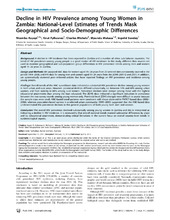| dc.contributor.author | Kayeyi, Nkomba | en_US |
| dc.contributor.author | Fylkesnes, Knut | en_US |
| dc.contributor.author | Michelo, Charles Cheembo | en_US |
| dc.contributor.author | Makasa, Mpundu | en_US |
| dc.contributor.author | Sandøy, Ingvild Fossgard | en_US |
| dc.date.accessioned | 2013-04-03T10:11:50Z | |
| dc.date.available | 2013-04-03T10:11:50Z | |
| dc.date.issued | 2012-04-04 | eng |
| dc.Published | PLoS ONE 7(4): e33652 | eng |
| dc.identifier.issn | 1932-6203 | |
| dc.identifier.uri | https://hdl.handle.net/1956/6472 | |
| dc.description.abstract | Background: A decline in HIV incidence has been reported in Zambia and a number of other sub-Saharan countries. The trend of HIV prevalence among young people is a good marker of HIV incidence. In this study, different data sources are used to examine geographical and sub-population group differentials in HIV prevalence trends among men and women aged 15–24 years in Zambia. Design and Methods: We analysed ANC data for women aged 15–24 years from 22 sentinel sites consistently covered in the period 1994–2008, and HIV data for young men and women aged 15–24 years from the ZDHS 2001/2 and 2007. In addition, we systematically reviewed peer-reviewed articles that have reported findings on HIV prevalence and incidence among young people. Findings: Overall trends of the ANC surveillance data indicated a substantial HIV prevalence decline among young women in both urban and rural areas. However, provincial declines differed substantially, i.e. between 10% and 68% among urban women, and from stability to 86% among rural women. Prevalence declines were steeper among those with the highest educational attainments than among the least educated. The ZDHS data indicated a significant reduction in prevalence between the two survey rounds among young women only. Provincial-level ZDHS changes were difficult to assess because the sample sizes were small. ANC-based trend patterns were consistent with those observed in PMTCT-based data (2002–2006), whereas population-based surveys in a selected urban community (1995–2003) suggested that the ANC-based data underestimated the prevalence declines in the general populations of both young both men and women. Conclusion: The overall HIV prevalence declined substantially among young women in Zambia and this is interpreted as indicating a decline in HIV incidence. It is noteworthy that overall national trends masked substantial differences by place and by educational attainment, demonstrating critical limitations in the current focus on overall country-level trends in epidemiological reports. | en_US |
| dc.language.iso | eng | eng |
| dc.publisher | Public Library of Science | eng |
| dc.relation.ispartof | <a href="http://hdl.handle.net/1956/6707" target="blank">Trends in HIV Prevalence and Sexual Behaviour among Young People in Zambia</a> | eng |
| dc.rights | Attribution CC BY | eng |
| dc.rights.uri | http://creativecommons.org/licenses/by/2.5/ | eng |
| dc.title | Decline in HIV Prevalence among Young Women in Zambia: National-Level Estimates of Trends Mask Geographical and Socio-Demographic Differences | en_US |
| dc.type | Peer reviewed | |
| dc.type | Journal article | |
| dc.description.version | publishedVersion | en_US |
| dc.rights.holder | Copyright 2012 Kayeyi et al. | |
| dc.identifier.doi | https://doi.org/10.1371/journal.pone.0033652 | |
| dc.identifier.cristin | 941695 | |

